2015 NISSAN LEAF ECU
[x] Cancel search: ECUPage 118 of 412
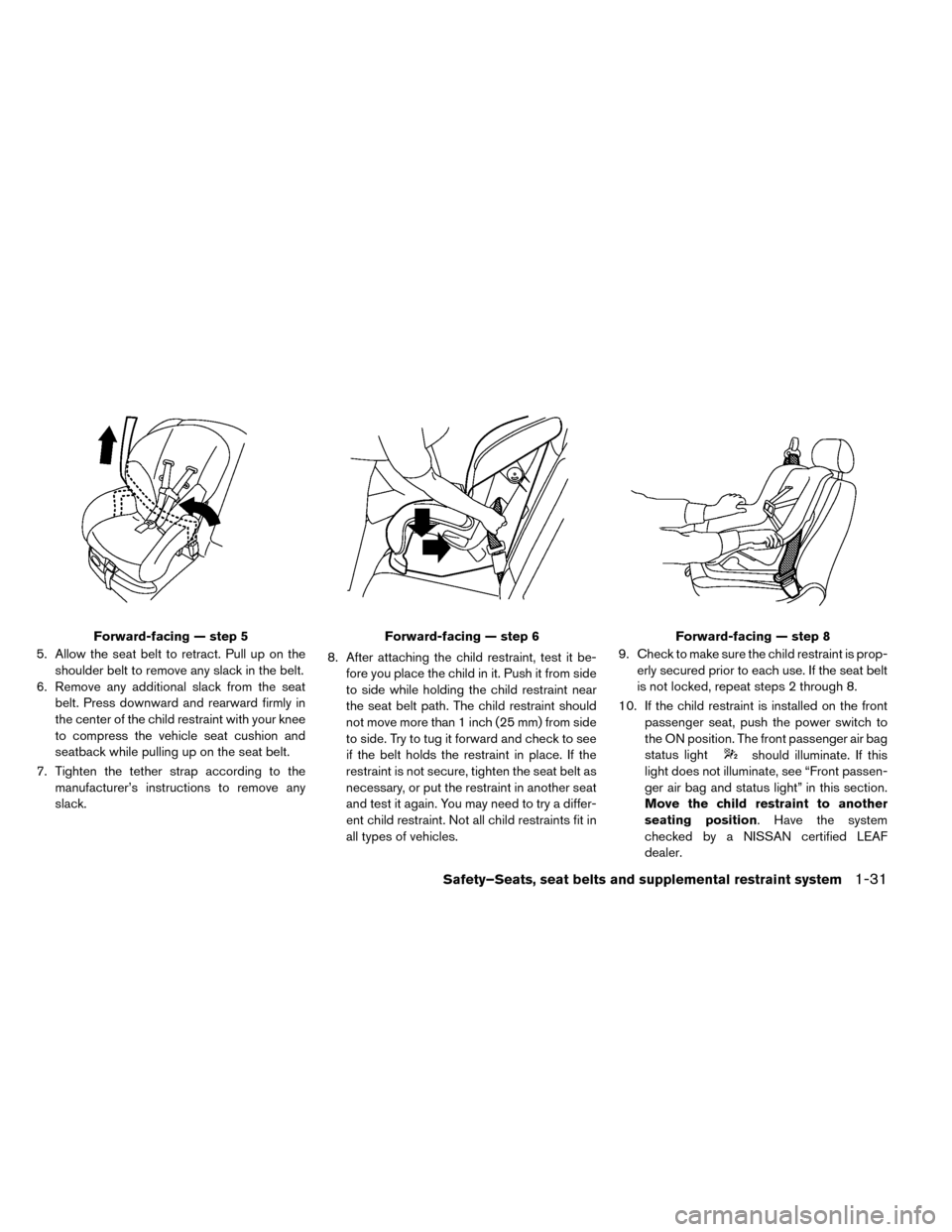
5. Allow the seat belt to retract. Pull up on theshoulder belt to remove any slack in the belt.
6. Remove any additional slack from the seat belt. Press downward and rearward firmly in
the center of the child restraint with your knee
to compress the vehicle seat cushion and
seatback while pulling up on the seat belt.
7. Tighten the tether strap according to the manufacturer’s instructions to remove any
slack. 8. After attaching the child restraint, test it be-
fore you place the child in it. Push it from side
to side while holding the child restraint near
the seat belt path. The child restraint should
not move more than 1 inch (25 mm) from side
to side. Try to tug it forward and check to see
if the belt holds the restraint in place. If the
restraint is not secure, tighten the seat belt as
necessary, or put the restraint in another seat
and test it again. You may need to try a differ-
ent child restraint. Not all child restraints fit in
all types of vehicles. 9. Check to make sure the child restraint is prop-
erly secured prior to each use. If the seat belt
is not locked, repeat steps 2 through 8.
10. If the child restraint is installed on the front passenger seat, push the power switch to
the ON position. The front passenger air bag
status light
should illuminate. If this
light does not illuminate, see “Front passen-
ger air bag and status light” in this section.
Move the child restraint to another
seating position. Have the system
checked by a NISSAN certified LEAF
dealer.
Forward-facing — step 5Forward-facing — step 6Forward-facing — step 8
Safety–Seats, seat belts and supplemental restraint system1-31
Page 119 of 412
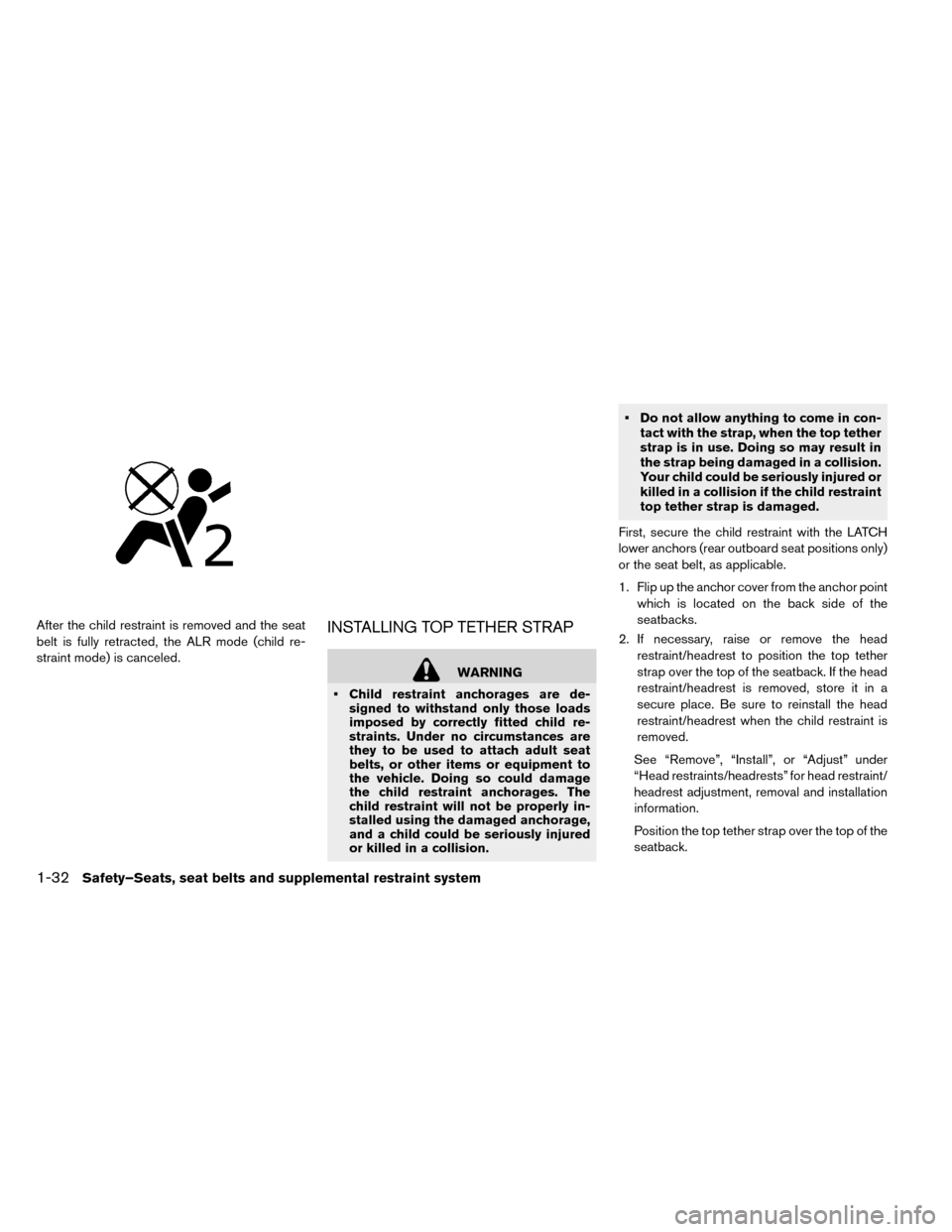
After the child restraint is removed and the seat
belt is fully retracted, the ALR mode (child re-
straint mode) is canceled.INSTALLING TOP TETHER STRAP
WARNING
• Child restraint anchorages are de- signed to withstand only those loads
imposed by correctly fitted child re-
straints. Under no circumstances are
they to be used to attach adult seat
belts, or other items or equipment to
the vehicle. Doing so could damage
the child restraint anchorages. The
child restraint will not be properly in-
stalled using the damaged anchorage,
and a child could be seriously injured
or killed in a collision. • Do not allow anything to come in con-
tact with the strap, when the top tether
strap is in use. Doing so may result in
the strap being damaged in a collision.
Your child could be seriously injured or
killed in a collision if the child restraint
top tether strap is damaged.
First, secure the child restraint with the LATCH
lower anchors (rear outboard seat positions only)
or the seat belt, as applicable.
1. Flip up the anchor cover from the anchor point which is located on the back side of the
seatbacks.
2. If necessary, raise or remove the head restraint/headrest to position the top tether
strap over the top of the seatback. If the head
restraint/headrest is removed, store it in a
secure place. Be sure to reinstall the head
restraint/headrest when the child restraint is
removed.
See “Remove”, “Install”, or “Adjust” under
“Head restraints/headrests” for head restraint/
headrest adjustment, removal and installation
information.
Position the top tether strap over the top of the
seatback.
1-32Safety–Seats, seat belts and supplemental restraint system
Page 120 of 412
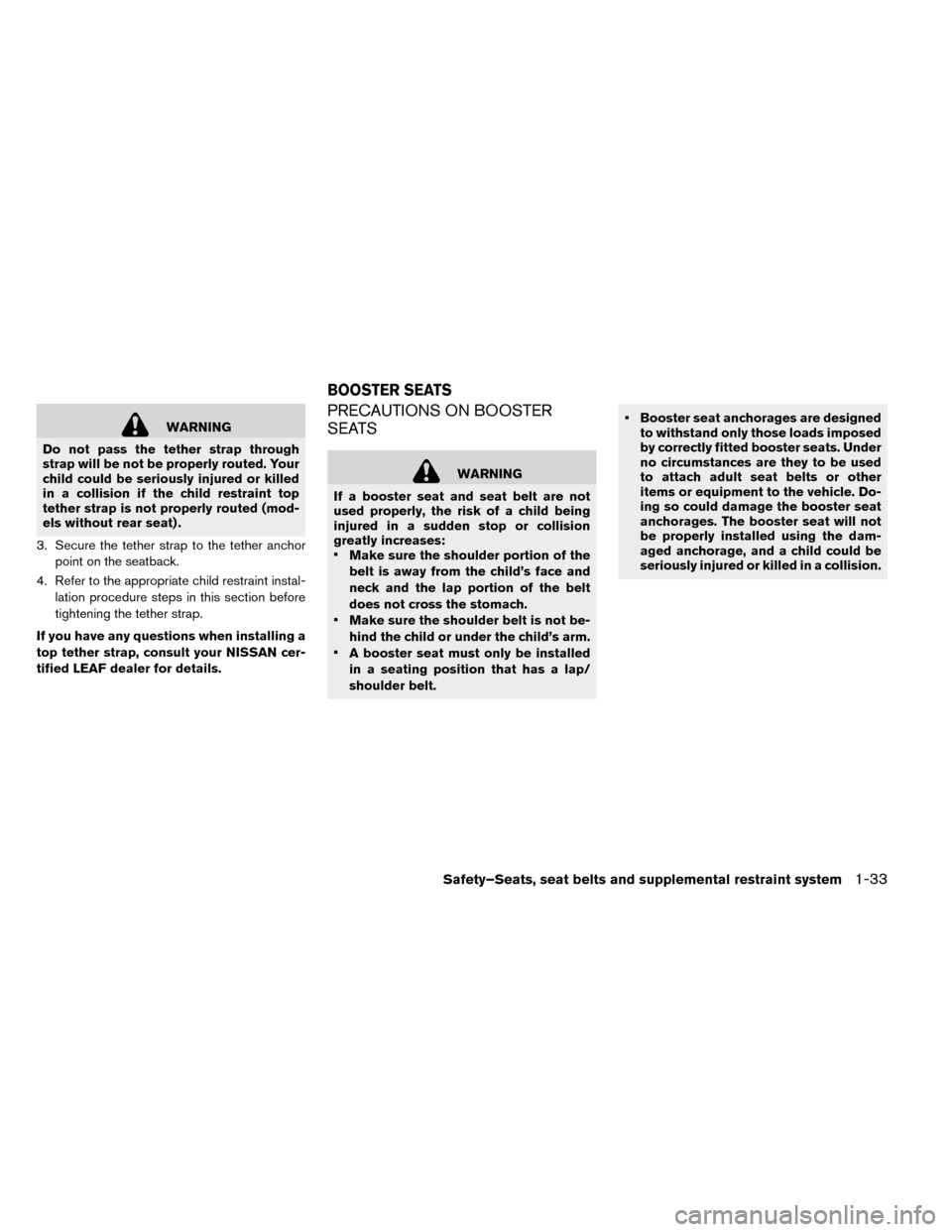
WARNING
Do not pass the tether strap through
strap will be not be properly routed. Your
child could be seriously injured or killed
in a collision if the child restraint top
tether strap is not properly routed (mod-
els without rear seat) .
3. Secure the tether strap to the tether anchor point on the seatback.
4. Refer to the appropriate child restraint instal- lation procedure steps in this section before
tightening the tether strap.
If you have any questions when installing a
top tether strap, consult your NISSAN cer-
tified LEAF dealer for details.
PRECAUTIONS ON BOOSTER
SEATS
WARNING
If a booster seat and seat belt are not
used properly, the risk of a child being
injured in a sudden stop or collision
greatly increases:
• Make sure the shoulder portion of the
belt is away from the child’s face and
neck and the lap portion of the belt
does not cross the stomach.
• Make sure the shoulder belt is not be-
hind the child or under the child’s arm.
• A booster seat must only be installed
in a seating position that has a lap/
shoulder belt. • Booster seat anchorages are designed
to withstand only those loads imposed
by correctly fitted booster seats. Under
no circumstances are they to be used
to attach adult seat belts or other
items or equipment to the vehicle. Do-
ing so could damage the booster seat
anchorages. The booster seat will not
be properly installed using the dam-
aged anchorage, and a child could be
seriously injured or killed in a collision.
BOOSTER SEATS
Safety–Seats, seat belts and supplemental restraint system1-33
Page 122 of 412

BOOSTER SEAT INSTALLATION
CAUTION
Do not use the lap/shoulder belt Auto-
matic Locking Retractor (ALR) mode
when using a booster seat with the seat
belts.
Refer to all Warnings and Cautions in “Child
safety”, “Child restraints” and “Booster seats” in
this section before installing a child restraint.
Follow these steps to install a booster seat on the
rear seat or on the front passenger seat:
1.If you must install a booster seat in the
front seat, move the seat to the rearmost
position.
2. Position the booster seat on the seat. Only place it in the forward-facing direction. Al-
ways follow the booster seat manufacturer’s
instructions.
3. The booster seat should be positioned on the vehicle seat so that it is stable. If necessary, adjust or remove the head
restraint/headrest to obtain the correct
booster seat fit. If the head restraint/headrest
is removed, store it in a secure place.
Be sure
to reinstall the head restraint/headrest
when the booster seat is removed. See
“Remove”, “Install” or “Adjust” under “Head
restraints/headrests” for head restraint/
headrest adjustment, removal and installation
information.
Front passenger seatFront passenger seat
Safety–Seats, seat belts and supplemental restraint system1-35
Page 132 of 412
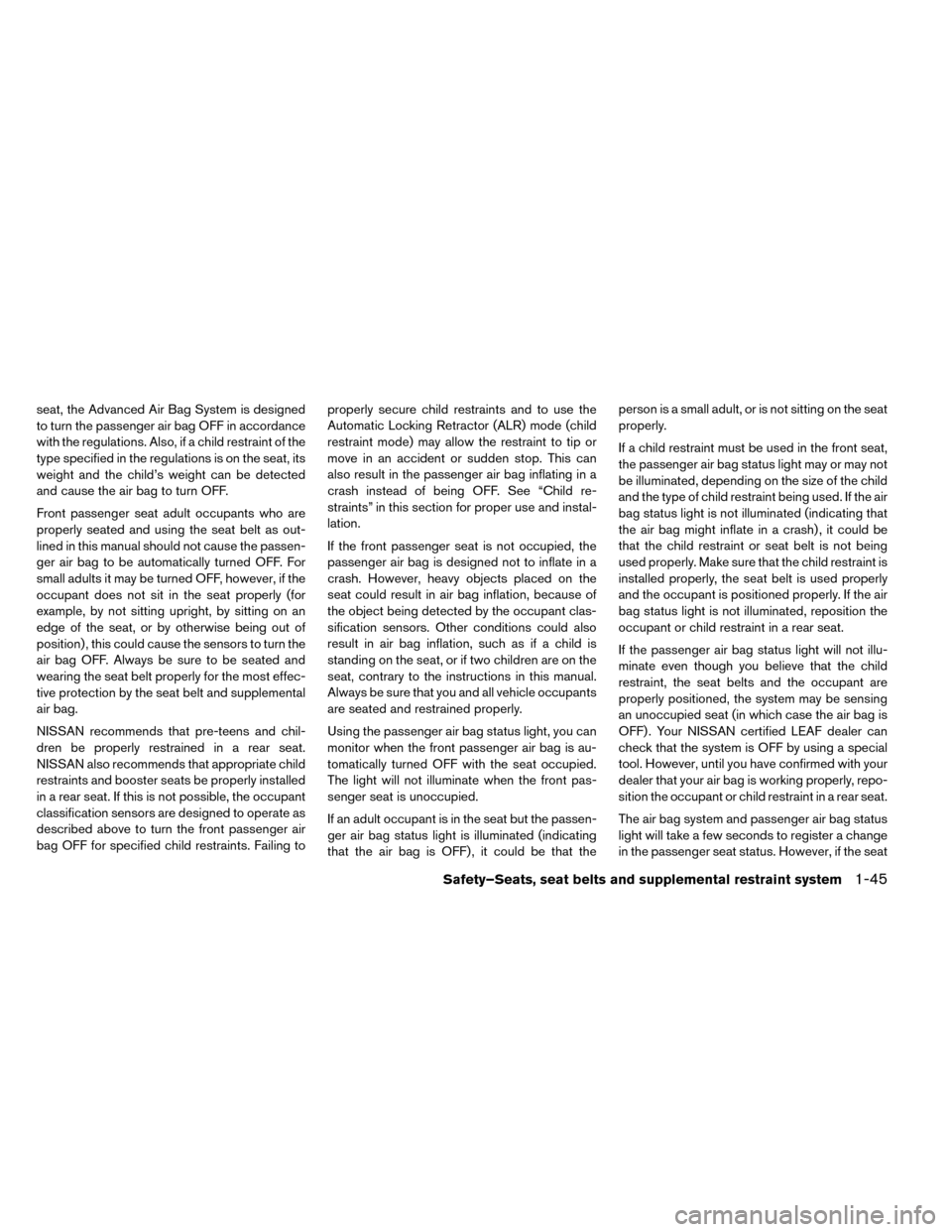
seat, the Advanced Air Bag System is designed
to turn the passenger air bag OFF in accordance
with the regulations. Also, if a child restraint of the
type specified in the regulations is on the seat, its
weight and the child’s weight can be detected
and cause the air bag to turn OFF.
Front passenger seat adult occupants who are
properly seated and using the seat belt as out-
lined in this manual should not cause the passen-
ger air bag to be automatically turned OFF. For
small adults it may be turned OFF, however, if the
occupant does not sit in the seat properly (for
example, by not sitting upright, by sitting on an
edge of the seat, or by otherwise being out of
position) , this could cause the sensors to turn the
air bag OFF. Always be sure to be seated and
wearing the seat belt properly for the most effec-
tive protection by the seat belt and supplemental
air bag.
NISSAN recommends that pre-teens and chil-
dren be properly restrained in a rear seat.
NISSAN also recommends that appropriate child
restraints and booster seats be properly installed
in a rear seat. If this is not possible, the occupant
classification sensors are designed to operate as
described above to turn the front passenger air
bag OFF for specified child restraints. Failing toproperly secure child restraints and to use the
Automatic Locking Retractor (ALR) mode (child
restraint mode) may allow the restraint to tip or
move in an accident or sudden stop. This can
also result in the passenger air bag inflating in a
crash instead of being OFF. See “Child re-
straints” in this section for proper use and instal-
lation.
If the front passenger seat is not occupied, the
passenger air bag is designed not to inflate in a
crash. However, heavy objects placed on the
seat could result in air bag inflation, because of
the object being detected by the occupant clas-
sification sensors. Other conditions could also
result in air bag inflation, such as if a child is
standing on the seat, or if two children are on the
seat, contrary to the instructions in this manual.
Always be sure that you and all vehicle occupants
are seated and restrained properly.
Using the passenger air bag status light, you can
monitor when the front passenger air bag is au-
tomatically turned OFF with the seat occupied.
The light will not illuminate when the front pas-
senger seat is unoccupied.
If an adult occupant is in the seat but the passen-
ger air bag status light is illuminated (indicating
that the air bag is OFF) , it could be that theperson is a small adult, or is not sitting on the seat
properly.
If a child restraint must be used in the front seat,
the passenger air bag status light may or may not
be illuminated, depending on the size of the child
and the type of child restraint being used. If the air
bag status light is not illuminated (indicating that
the air bag might inflate in a crash) , it could be
that the child restraint or seat belt is not being
used properly. Make sure that the child restraint is
installed properly, the seat belt is used properly
and the occupant is positioned properly. If the air
bag status light is not illuminated, reposition the
occupant or child restraint in a rear seat.
If the passenger air bag status light will not illu-
minate even though you believe that the child
restraint, the seat belts and the occupant are
properly positioned, the system may be sensing
an unoccupied seat (in which case the air bag is
OFF) . Your NISSAN certified LEAF dealer can
check that the system is OFF by using a special
tool. However, until you have confirmed with your
dealer that your air bag is working properly, repo-
sition the occupant or child restraint in a rear seat.
The air bag system and passenger air bag status
light will take a few seconds to register a change
in the passenger seat status. However, if the seat
Safety–Seats, seat belts and supplemental restraint system1-45
Page 140 of 412
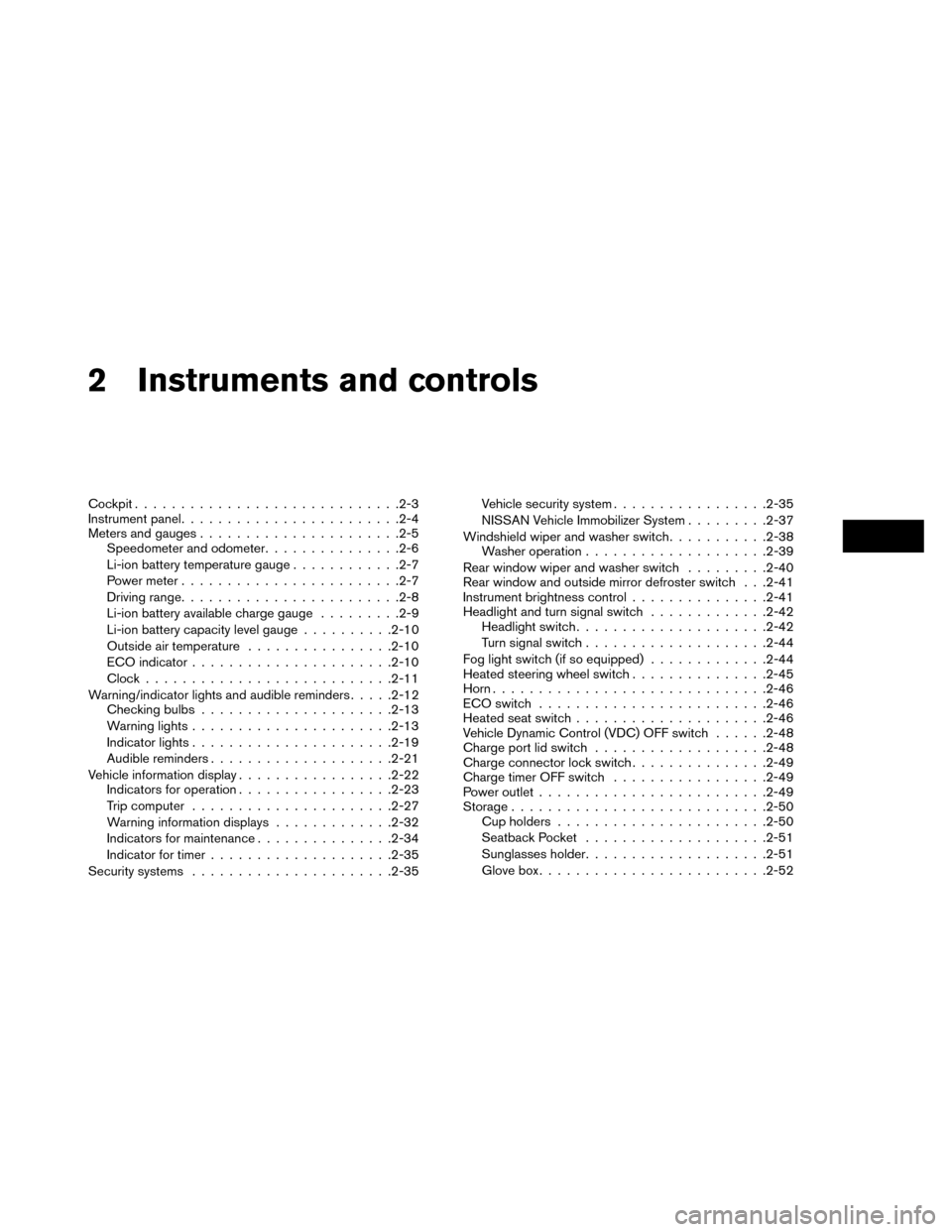
2 Instruments and controls
Cockpit............................ .2-3
Instrument panel ....................... .2-4
Meters and gauges ..................... .2-5
Speedometer and odometer ...............2-6
Li-ion battery temperature gauge ............2-7
Power meter ....................... .2-7
Driving range ....................... .2-8
Li-ion battery available charge gauge .........2-9
Li-ion battery capacity level gauge ..........2-10
Outside air temperature ................2-10
ECO indicator ..................... .2-10
Clock .......................... .2-11
Warning/indicator lights and audible reminders .....2-12
Checking bulbs .................... .2-13
Warning lights ..................... .2-13
Indicator lights ..................... .2-19
Audible reminders ................... .2-21
Vehicle information display .................2-22
Indicators for operation ................ .2-23
Trip computer ..................... .2-27
Warning information displays .............2-32
Indicators for maintenance ...............2-34
Indicator for timer ................... .2-35
Security systems ..................... .2-35Vehicle security system
................ .2-35
NISSAN Vehicle Immobilizer System .........2-37
Windshield wiper and washer switch ...........2-38
Washer operation ................... .2-39
Rear window wiper and washer switch .........2-40
Rear window and outside mirror defroster switch . . .2-41
Instrument brightness control ...............2-41
Headlight and turn signal switch .............2-42
Headlight switch .................... .2-42
Turn signal switch ................... .2-44
Fog light switch (if so equipped) .............2-44
Heated steering
wheel switch ...............2-45
Horn ............................. .2-46
ECO switch ........................ .2-46
Heated seat switch .................... .2-46
Vehicle Dynamic Control (VDC) OFF switch ......2-48
Charge port lid switch .................. .2-48
Charge connector lock switch ...............2-49
Charge timer OFF switch .................2-49
Power outlet ........................ .2-49
Storage ........................... .2-50
Cup holders ...................... .2-50
Seatback Pocket ................... .2-51
Sunglasses holder ................... .2-51
Glove box ........................ .2-52
Page 151 of 412
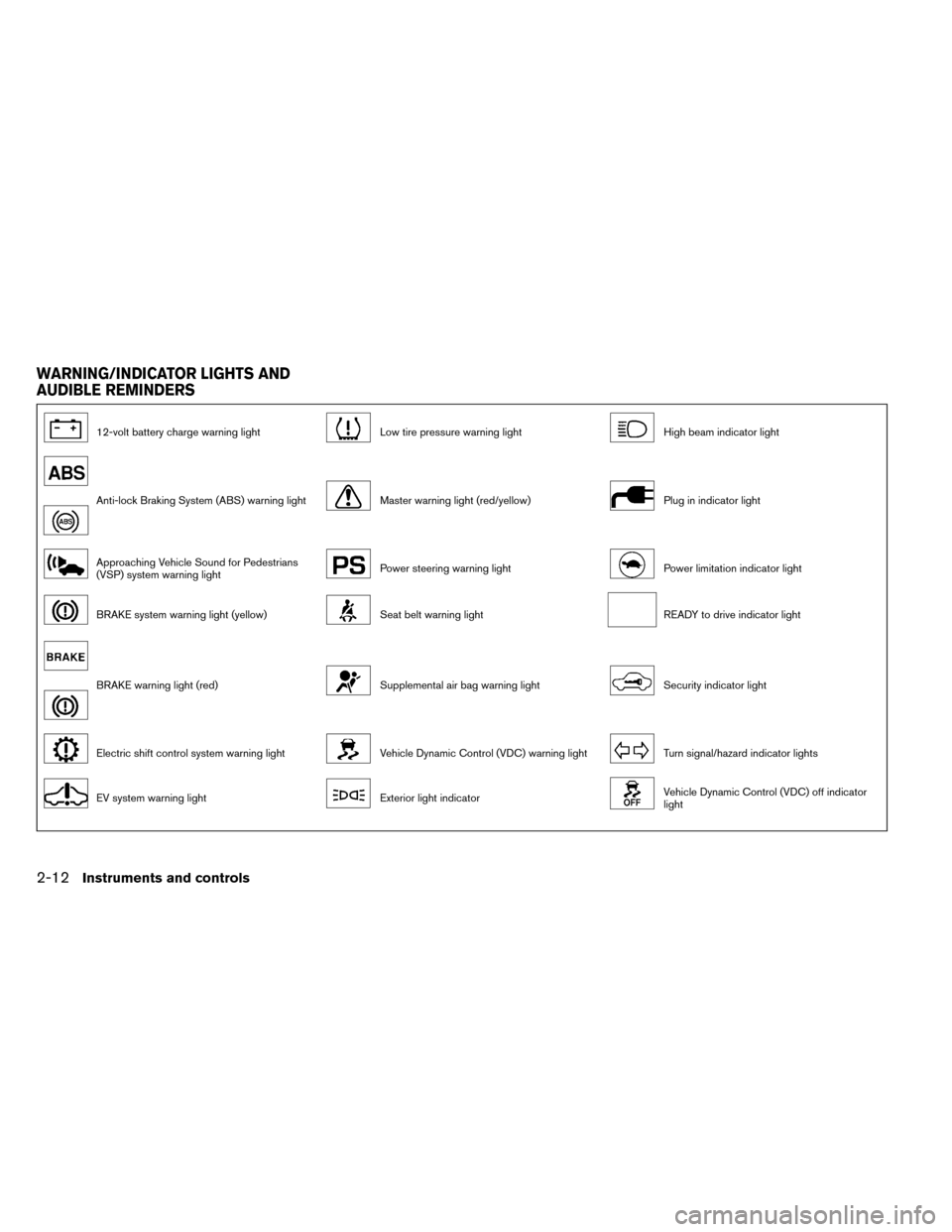
12-volt battery charge warning lightLow tire pressure warning lightHigh beam indicator light
Anti-lock Braking System (ABS) warning lightMaster warning light (red/yellow)Plug in indicator light
Approaching Vehicle Sound for Pedestrians
(VSP) system warning lightPower steering warning lightPower limitation indicator light
BRAKE system warning light (yellow)Seat belt warning lightREADY to drive indicator light
BRAKE warning light (red)Supplemental air bag warning lightSecurity indicator light
Electric shift control system warning lightVehicle Dynamic Control (VDC) warning lightTurn signal/hazard indicator lights
EV system warning lightExterior light indicatorVehicle Dynamic Control (VDC) off indicator
light
WARNING/INDICATOR LIGHTS AND
AUDIBLE REMINDERS
2-12Instruments and controls
Page 157 of 412
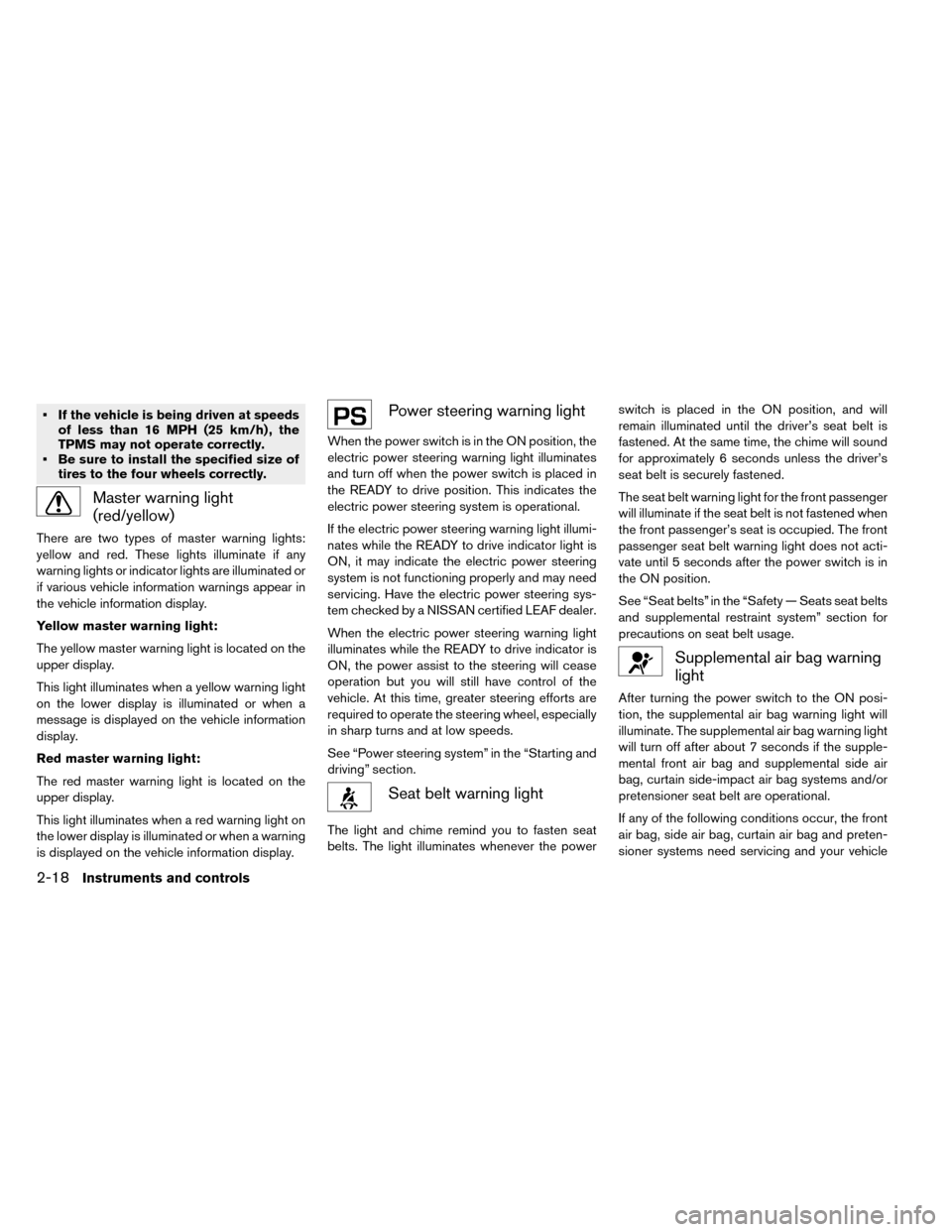
• If the vehicle is being driven at speedsof less than 16 MPH (25 km/h) , the
TPMS may not operate correctly.
• Be sure to install the specified size of tires to the four wheels correctly.
Master warning light
(red/yellow)
There are two types of master warning lights:
yellow and red. These lights illuminate if any
warning lights or indicator lights are illuminated or
if various vehicle information warnings appear in
the vehicle information display.
Yellow master warning light:
The yellow master warning light is located on the
upper display.
This light illuminates when a yellow warning light
on the lower display is illuminated or when a
message is displayed on the vehicle information
display.
Red master warning light:
The red master warning light is located on the
upper display.
This light illuminates when a red warning light on
the lower display is illuminated or when a warning
is displayed on the vehicle information display.
Power steering warning light
When the power switch is in the ON position, the
electric power steering warning light illuminates
and turn off when the power switch is placed in
the READY to drive position. This indicates the
electric power steering system is operational.
If the electric power steering warning light illumi-
nates while the READY to drive indicator light is
ON, it may indicate the electric power steering
system is not functioning properly and may need
servicing. Have the electric power steering sys-
tem checked by a NISSAN certified LEAF dealer.
When the electric power steering warning light
illuminates while the READY to drive indicator is
ON, the power assist to the steering will cease
operation but you will still have control of the
vehicle. At this time, greater steering efforts are
required to operate the steering wheel, especially
in sharp turns and at low speeds.
See “Power steering system” in the “Starting and
driving” section.
Seat belt warning light
The light and chime remind you to fasten seat
belts. The light illuminates whenever the power switch is placed in the ON position, and will
remain illuminated until the driver’s seat belt is
fastened. At the same time, the chime will sound
for approximately 6 seconds unless the driver’s
seat belt is securely fastened.
The seat belt warning light for the front passenger
will illuminate if the seat belt is not fastened when
the front passenger’s seat is occupied. The front
passenger seat belt warning light does not acti-
vate until 5 seconds after the power switch is in
the ON position.
See “Seat belts” in the “Safety — Seats seat belts
and supplemental restraint system” section for
precautions on seat belt usage.
Supplemental air bag warning
light
After turning the power switch to the ON posi-
tion, the supplemental air bag warning light will
illuminate. The supplemental air bag warning light
will turn off after about 7 seconds if the supple-
mental front air bag and supplemental side air
bag, curtain side-impact air bag systems and/or
pretensioner seat belt are operational.
If any of the following conditions occur, the front
air bag, side air bag, curtain air bag and preten-
sioner systems need servicing and your vehicle
2-18Instruments and controls